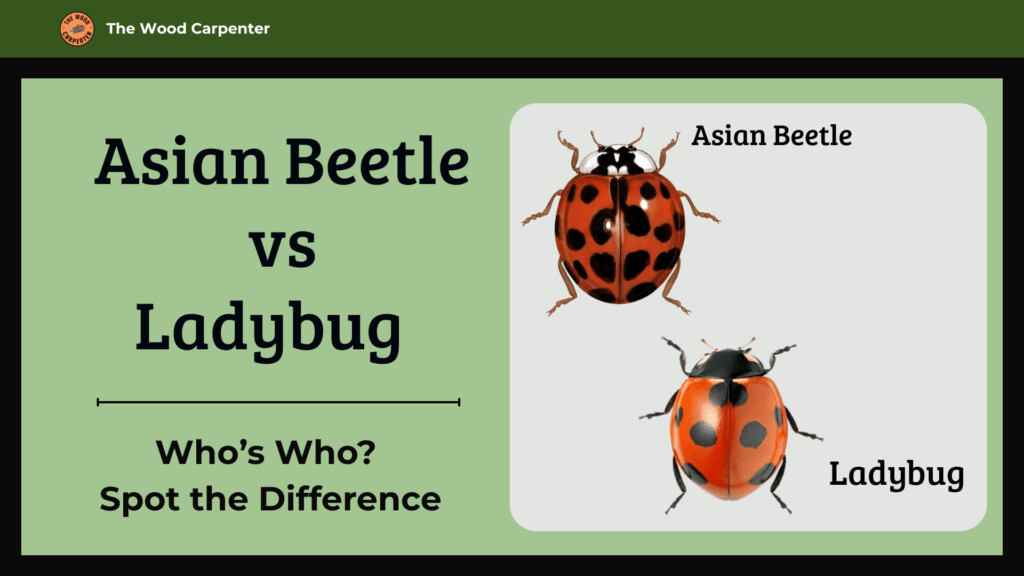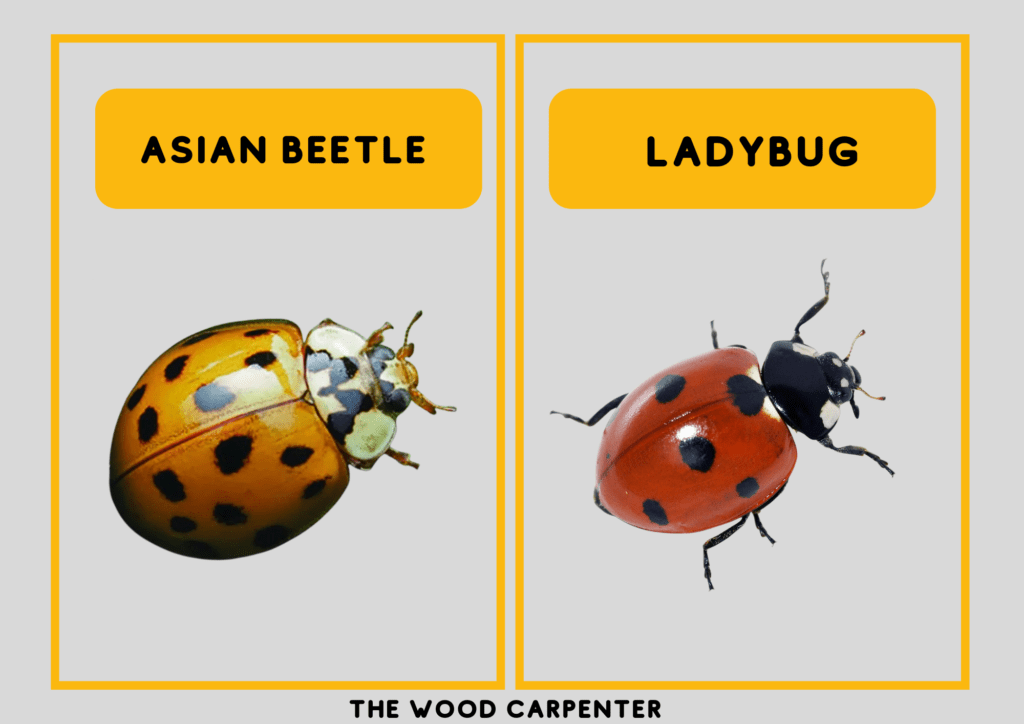
Asian Beetle vs Ladybugs: Ever had a baby red beetle land on your arm and someone close by say, “What luck! Don’t move”?? Odds are, they were referring to a ladybug, possibly one of the most popular garden bugs. But here’s the kicker — not all “ladybugs” are actually ladybugs. A few of them are, in fact, Asian lady beetles and though they can look alike their behavior couldn’t be more different.
If you’ve ever spotted dozens (or hundreds!) of tiny red beetles crawling along your walls or windows in the fall, that wasn’t good luck — it was an infestation of Asian lady beetles. These bugs may sport the same adorable, spotted look, but their diets consist of little more than drop dead gorgeous.
Let’s delve deep into this intriguing insect beef — the Asian lady beetle vs. the ladybug — and find out how to identify them, why one is a friend and the other a foe, as well as what you can do when these little guys knock on your door.
🌿 A Tale of Two Bugs
The Friendly Face of Nature: The True Ladybug
The ladybug, scientifically known as Coccinellidae, is one of nature’s greatest little helpers. Native to North America, these bright red beetles are tiny garden warriors. They feast on aphids, mites, and other small pests that destroy plants.
Gardeners positively adore them — and with good reason. One ladybug resists 5,000 aphids or more during its lifetime. That would be a lot of free pest control!
In addition to all this utility, ladybugs have a magical quality about them. In numerous cultures, they are symbols of luck, love and protection. I can still remember as a child, holding something in my hand and making a wish as it flew away on its tiny wings. Therein lies what makes ladybugs so charming — they aren’t harmless, gentle and beneficial.
The Uninvited Houseguest: The Asian Lady Beetle
Now, meet the Asian lady beetle (Harmonia axyridis). One could easily be mistaken for a ladybug at first glance. They’re red or orange, they’re spotted and they belong to the same extended family of beetles. But the similarities end there.
Asian lady beetles are not a North American native. They were originally brought from Asia in the early 1900s — and again in the 1970s and ’80s by agricultural agencies seeking natural control over crop pests. The notion was solid — the results, not so much.
These beetles multiplied like crazy, spread far and wide and got into fights with native ladybugs over food and living spaces. In time, they became an invasive species, more associated with invading homes than helping gardens.
🔍 How to Tell Them Apart: Ladybug vs Asian Lady Beetle
If you’ve ever wondered, “How can I tell whether I’m looking at a ladybug or an Asian beetle?” — here’s your quick visual guide.
1. Color and Spots
- Ladybugs are typically bright red or red-orange with bold black spots. Their appearance is consistent across most species.
- Asian lady beetles vary widely — they can be red, orange, or even tan, with many spots, few spots, or none at all.
If you find a light-orange beetle with little or no spots, it’s likely an Asian lady beetle.
2. The Distinctive “M” Mark
This is the giveaway feature. Look closely at the area just behind the beetle’s head — the pronotum.
- Asian lady beetles have a black “M”-shaped mark (or sometimes a “W,” depending on how you view it).
- Ladybugs lack this mark and usually have solid black heads with small white patches near their eyes.
That “M” is your best clue that you’re looking at an Asian intruder.

3. Shape and Size
Ladybugs are small and round, while Asian beetles are slightly larger and more oval-shaped. Side by side, you’ll notice the Asian beetle looks a bit longer.
4. Behavior
This might be the most telling difference of all.
- Ladybugs are outdoor insects. They overwinter under leaves, bark, or logs. You’ll rarely find them inside your house.
- Asian beetles, on the other hand, seek warmth indoors when the weather cools. They swarm on sunny walls and windows, often entering through tiny cracks or vents.
If your home seems covered in little red bugs every fall — those are Asian lady beetles saying hello (and refusing to leave).
Related Topics:
6 Ways to Get Rid of Boxelder Bugs Naturally & Effectively
Spider Crickets: 7 Effective & Easy Ways to Get Rid of them
😖 The Trouble With Asian Lady Beetles
While they don’t cause serious structural damage like termites, Asian lady beetles are definitely pests.
They gather in huge numbers, crawling on walls, ceilings, and windows. When disturbed, they release a foul-smelling yellow fluid that stains surfaces and can trigger mild allergic reactions in some people.
It’s a process known as reflex bleeding — and it’s how they protect themselves. Unfortunately, the yellowish secretion has a foul odor and causes dark stains on walls, curtains and furniture.
Some people even have irritated eyes or skin when they are in the presence of many of these beetles, particularly while being crushed.
To add insult to injury, Asian beetles can bite. It’s not really a sting — more a little pinch — but it is sufficiently unpleasant.
🌸 Why Ladybugs Are Garden Heroes
In contrast, ladybugs are the good guys of the insect world. Gardeners rely on them for helping to keep pest numbers in check cleanly and naturally. They feed on the harmful insects that destroy plant leaves, flowers, herbs and produce in gardens.Some flowering plants bloom earlier when aphids thrive.Bring some ladybugs to your garden and delight in the rewards.
You can attract more ladybugs to your garden by:
- Planting flowers like dill, fennel, marigold, and cosmos
- Avoiding pesticides in the lawn that kill valuable insects
- Creating small shelters with leaves, twigs, or flowerpots
The result? An attractive, healthy garden with natural beauty and no chemical residue in sight.
🏡 Keeping Asian Lady Beetles Out of Your Home
If you’ve already got Asian lady beetles making themselves at home in your walls, windows or even light fixtures, do not panic. You can take necessary actions to stop them.
Here’s how to prevent an infestation:
Seal entry points – Caulk cracks and gaps around windows, doors, eaves, and vents. Prevention is your best defense.
Check screens and weatherstripping – Even small tears are an invitation for hundreds of beetles to enter your home.
Use a vacuum – that’ll suck them up rather than squashing them. Always dispose of the vacuum bag outside.
Clean surfaces – Wipe down the areas where you see beetles with soapy water or vinegar
Use natural repellents – Essential oils like citronella, citrus, or peppermint will repel them effectively without harsh chemicals.
Limit outdoor attraction – Asian beetles are drawn to light-colored homes. Painting darker shades or minimizing bright exterior lights can help.
By taking these simple steps, you can keep your home bug-free without harming the environment.
Related Topics:
5 Ways to Get Rid of Potato Bugs Fast!
Deer or Wood Tick: Which Is Worse?
🌍 A Lesson in Ecology: When Good Intentions Go Wrong
The story of the Asian lady beetle is a reminder that nature doesn’t like shortcuts. Scientists introduced them to control pests, but they ended up creating a new problem — one that displaced native ladybugs and disrupted ecosystems.
It’s an example of how delicate nature’s balance can be. Even a small change can ripple through entire environments. These days, Asian lady beetles still flourish in much of the country– at the expense of their native cousins.
That said, not all of them are bad. They do eat aphids and some garden pests, much like ladybugs do. The real issue isn’t what they eat — it’s where they live and how they behave.
Of course, they’re not all bad. But they do eat aphids and certain garden pests, much like ladybugs do. What they’re eating isn’t the real problem — it’s where they live, and how they behave.
💬 Real-Life Experience: When “Ladybugs” Took Over My Living Room
Last fall, I noticed what I thought were ladybugs gathering on my sunny kitchen window. Cute, right? Until I realized there were hundreds of them — crawling across the blinds, the ceiling, and even hiding behind picture frames.
That’s when I discovered the truth: I wasn’t hosting ladybugs at all. They were Asian lady beetles, and they weren’t planning to leave any time soon.
It took sealing every crack, using peppermint oil spray, and a good vacuum session to finally get rid of them. Lesson learned — when beetles start swarming indoors, they’re probably the wrong kind of “ladybug.”
❓Frequently Asked Questions (FAQs)
1. Are Asian lady beetles harmful?
Asian lady beetles don’t spread diseases, but they can bite lightly and cause allergic reactions in sensitive individuals. Their yellow secretion can stain walls and fabrics, and large infestations can become a nuisance indoors.
2. What is the difference between Asian beetles and ladybugs?
Ladybugs are native, beneficial insects that stay outdoors and help control pests. Asian beetles are invasive, more aggressive, and tend to gather in homes during cooler months. The easiest way to tell them apart is the black “M” mark behind the Asian beetle’s head.
3. Should I squish Asian lady beetles?
No — avoid crushing them. Squishing them will also get the smelly yellow fluid on whatever they are squished on, likely ending up in a stain and attracting more beetles. So instead vacuum them up and discard outside.
4. Are ladybugs good or bad in the house?
Ladybugs are not harmful, but they don’t usually come indoors. If you find a few wandering inside, they’re harmless and they can be gently relocated outdoors. However, if you’re seeing large numbers, you’re likely dealing with Asian lady beetles, not true ladybugs.
5. Do Asian beetles kill ladybugs?
Yes, they do sometimes eat native ladybugs or compete them off for food and nesting sites, leading to diminished numbers of local ladybugs.
6. How can I prevent Asian lady beetles from entering my home?
Seal entry points, patch screens and deploy natural repellents like citrus or citronella oil around windows and doors before the fall season starts.
🌞 Final Thoughts
The story of Asian lady beetles versus native ladybugs isn’t just how they look, it’s about nature’s equilibrium, adaptability and occasional fallout.
Ladybugs are the gentle heroes of the garden, bringing the good luck and keeping the plants pest-free. Asian beetles, while they are similar in appearance, they can quickly become unwanted guests inside your home.
So, on your next encounter with one of those little spotted red beetles that land on you sleeve, take a close-up look. If you come across that notorious black “M,” you will know what you are dealing with the imposter.
And though there’s no need for panic, it’s a good reminder that not every pretty face in nature is your friend.

